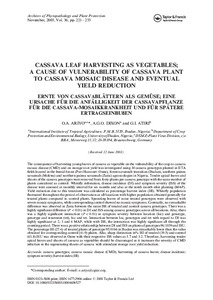| dc.contributor.author | Ariyo, O.A. |
| dc.contributor.author | Dixon, Alfred G.O. |
| dc.contributor.author | Atiri, G.I. |
| dc.date.accessioned | 2019-12-04T11:23:51Z |
| dc.date.available | 2019-12-04T11:23:51Z |
| dc.date.issued | 2003-11 |
| dc.identifier.citation | Ariyo, O.A., Dixon, A.G.O. & Atiri, G.I. (2003). Cassava leaf harvesting as vegetables; a cause of vulnerability of cassava plant to cassava mosaic disease and eventual yield reduction: Ernte von cassavablättern als gemüse; eine ursache für die anfälligkeit der cassavapflanze für die cassava-mosaikkrankheit und für spätere ertragseinbußen. Archives of Phytopathology and Plant Protection, 36(3-4), 221-233. |
| dc.identifier.issn | 0323-5408 |
| dc.identifier.uri | https://hdl.handle.net/20.500.12478/4180 |
| dc.description.abstract | The consequence of harvesting young leaves of cassava as vegetable on the vulnerability of the crop to cassava mosaic disease (CMD) and on storage root yield was investigated using 30 cassava genotypes planted in IITA fields located in the humid forest (Port Harcourt : Onne), forest-savannah transition (Ibadan), southern guinea savannah (Mokwa) and northern guinea savannah (Zaria) agroecologies in Nigeria. Tender apical leaves and shoots of the cassava genotypes were removed from forty plants per cassava genotype with the same number of plants considered as control. Whitefly infestation, disease incidence (DI) and symptom severity (ISS) of the disease were assessed at monthly interval for six months and also at the ninth month after planting (MAP). Yield reduction due to this treatment was calculated as percentage harvest index (HI). Whitefly population fluctuated throughout the period of observation at all locations with higher population obtained generally for treated plants compared to control plants. Sprouting leaves of some treated genotypes were observed with severe mosaic symptoms, while corresponding control showed no mosaic symptoms. Contrarily, no remarkable difference was observed in Zaria between the mean ISS of treated and control cassava genotypes. There was a highly significant difference (P < 0.01) in DI and ISS among cassava genotypes across all locations. Also, there was a highly significant interaction (P < 0.01) in symptom severity between location (loc) and genotype, genotype and treatment (trt), loc and trt. Interaction between loc, genotypes and trt with regard to DI was highly significant at 2, 3 and 4 MAP, while with ISS, the interaction was highly significant all through the counting period. There was a positive relationship between DI and ISS on plants of genotypes 96/1039 and ISU. The percentage HI (27.4) of treated plants of genotype 95/0166 in Ibadan was remarkably lower than the value obtained for corresponding control (41.9) plants. Also, sharp distinction in% HI of treated (39.5) and control (43.8) ISU was observed in Onne with their respective ISS values as 3.7 and 3.2. Therefore, harvesting tender apical leaves and shoots of cassava as vegetables should be discouraged as it increases the severity of CMD infection in the regenerating shoots of cassava with attendant storage root yield reduction. |
| dc.language.iso | en |
| dc.subject | Cassava |
| dc.subject | Genotypes |
| dc.subject | Plant Diseases |
| dc.subject | Disease Incidence |
| dc.subject | Harvest Index |
| dc.title | Cassava leaf harvesting as vegetables: a cause of vulnerability of cassava plants to cassava mosaic disease and eventual yield reduction |
| dc.type | Journal Article |
| dc.type | Journal Article |
| dc.description.version | Peer Review |
| cg.contributor.crp | Roots, Tubers and Bananas |
| cg.contributor.affiliation | International Institute of Tropical Agriculture |
| cg.contributor.affiliation | University of Ibadan |
| cg.coverage.region | Africa |
| cg.coverage.region | West Africa |
| cg.coverage.country | Nigeria |
| cg.isijournal | ISI Journal |
| cg.authorship.types | CGIAR and developing country institute |
| cg.iitasubject | Cassava |
| cg.accessibilitystatus | Limited Access |
| local.dspaceid | 99746 |
| cg.identifier.doi | https://doi.org/10.1080/03235400310001608527 |

